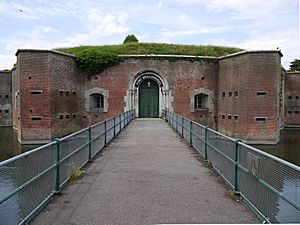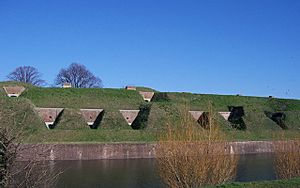Fort Brockhurst facts for kids
Quick facts for kids Fort Brockhurst |
|
|---|---|

Fort Brockhurst entrance
|
|
| Type | Palmerston Fort |
| Location | Gosport |
| OS grid reference | SU 59600 02063 |
| Area | Hampshire |
| Built | 1858–1862 |
| Architect | William Crossman |
| Owner | English Heritage |
| Official name: Fort Brockhurst, Gosport | |
| Designated | 7 Aug 1967 |
| Reference no. | 1013401 |
| Lua error in Module:Location_map at line 420: attempt to index field 'wikibase' (a nil value). | |
Fort Brockhurst is a cool old fort in Gosport, England. It's one of the famous Palmerston Forts. These forts were built a long time ago to protect important places. Today, Fort Brockhurst is a scheduled monument, which means it's a very important historical site. It is now looked after by English Heritage, a group that cares for historic places.
Contents
The Story of Fort Brockhurst
Building a Stronghold: 1858–1862
Fort Brockhurst was designed by William Crossman in the 1800s. Its main job was to protect Portsmouth from possible attacks. It was built between 1858 and 1862. This fort was part of a group of five similar forts. These forts were called the Gosport Advanced Line.
The other forts were Fort Elson, Fort Grange, Fort Rowner, and Fort Gomer. These forts had powerful guns. Their main goal was to guard the dockyards from enemies landing on the Hampshire coast. People at the time were worried about a French invasion. Luckily, this invasion never happened.
Interestingly, new cannon technology changed very quickly. This meant the fort was already a bit old-fashioned before it was even finished! The new cannons could shoot much farther. This made Fort Brockhurst too close to the dockyard. An enemy could land elsewhere and still attack Portsmouth Harbour. Because of this, Fort Fareham was built farther away. It was finished six years later in 1868.
Life at the Fort: 1862–1957
From 1882, Fort Brockhurst became a special place. It was used as a depot for soldiers coming back from India. These soldiers had finished their time serving in the army. In 1898, about 9,000 to 10,000 soldiers passed through the fort each year.
In the 1880s, it took about a week for a large group of soldiers to complete their paperwork. But later, soldiers only stayed a few days. After finishing all the necessary steps, they joined the Army Reserve. Then they went back to their normal lives. The ex-soldiers would march to Fort Brockhurst railway station. From there, they took a train home.
In August 1914, a special army unit was formed at the fort. It was called the 9th (Heavy) Battery Royal Garrison Artillery. This happened during the time of Kitchener's Army in World War I. During World War II, the fort had some minor bomb damage. But it was never used for its original purpose in a battle. The fort stayed active until 1957. It was used for housing, storage, and training soldiers.
Fort Brockhurst Today: An English Heritage Site
Even though modern buildings are now around the fort, it still looks much like it did. You can still see the parade ground where soldiers marched. The gun ramps and the moated keep are also still there.
Some parts of the fort show damage from World War II bombs. This damage lets you see how the fort's walls, called casemates, were built. Today, Fort Brockhurst is used to store old items from English Heritage's collections. Sometimes, the fort is open for people to visit. The outdoor grounds are usually open to everyone.
Exploring Fort Brockhurst's Design
The fort's shape was quite new for its time. It was built in a "polygonal" shape, meaning it had many sides. This was different from older forts that had angled bastions. The new design allowed more heavy guns to be placed on the walls. This made the fort better at attacking than just defending. Each fort was built close enough to the next. This meant they could help each other in a fight.
The fort was surrounded by a moat, like a medieval castle. You would cross a drawbridge on the southeast side to get in. This led to a round building called a keep. The keep also had its own moat. It was used for local defense and had twenty light guns.
The main guns, nineteen heavy ones, were on the fort's walls, called ramparts. Two ramps on the parade ground led up to these guns. There was also a lower level with eight guns. These guns helped create cross-fire with Fort Elson and Fort Rowner. Outside the moat, on the north side, was a triangular area called a redan. Riflemen could use this to stop enemies trying to cross the moat. Similarly, small towers called caponiers were at the corners of the ramparts. These also let riflemen protect the moat.
Fort Rowner, to the southwest, is also well-preserved. However, a military base was built around it in 1914. This base is now known as HMS Sultan. Fort Rowner is only open to the public once a year.


